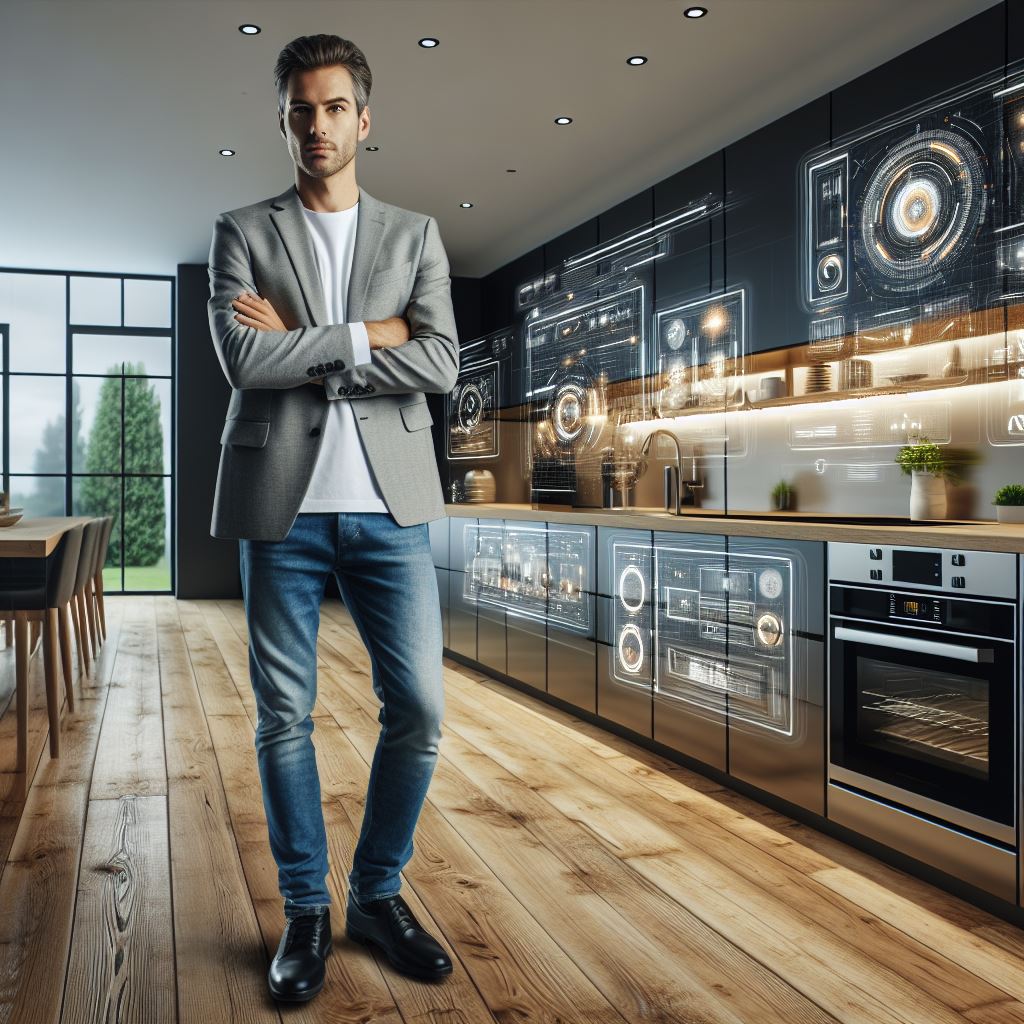Introduction
In the evolving landscape of real estate, tech-enhanced kitchens have emerged as a significant factor in influencing homebuyers’ decisions.
These kitchens are not just spaces for cooking; they are hubs of innovation and convenience, seamlessly integrating technology to enhance functionality and appeal.
In this post, we’ll explore the essence of tech-enhanced kitchens, their pivotal role in real estate, and the myriad benefits they bring to the housing market.
Tech-enhanced kitchens are equipped with cutting-edge appliances, smart devices, and integrated systems that streamline cooking processes and elevate user experience.
From smart refrigerators that manage inventory to voice-controlled assistants guiding recipes, these kitchens redefine convenience and efficiency.
Features like touchless faucets, induction cooktops, and built-in sensors further exemplify the fusion of technology with traditional kitchen elements, creating spaces that are both modern and functional.
In the realm of real estate, kitchens often serve as focal points during property evaluations.
Tech-enhanced kitchens not only add aesthetic value but also signify the home’s adaptability to modern living standards.
Homebuyers increasingly prioritize convenience and efficiency, and a technologically advanced kitchen can significantly influence their purchasing decisions.
Furthermore, real estate agents recognize the competitive edge that tech-enhanced kitchens offer in marketing properties, attracting discerning buyers seeking contemporary living spaces.
The integration of technology in kitchens presents a multitude of benefits within the housing market.
Smart Appliances
A. Definition and examples of smart appliances
Smart appliances refer to household kitchen appliances that can connect to the internet or other devices.
Examples of smart appliances include smart refrigerators, smart ovens, smart dishwashers, and smart coffee makers.
B. Advantages of smart appliances in a kitchen
- Increased energy efficiency: Smart appliances are designed to minimize energy consumption, resulting in lower utility bills.
- Improved convenience and functionality: Smart appliances offer advanced features like remote control and voice commands.
- Enhanced safety features: Smart appliances come with safety sensors and alerts to prevent accidents and hazards.
C. Integration of smart appliances with home automation systems
Smart appliances can be integrated with home automation systems to create a fully connected and automated kitchen.
Homeowners can control their smart appliances through a central hub or smartphone application.
Integration allows for seamless operation and coordination between various kitchen appliances.
For example, a smart refrigerator can send a notification to the homeowner’s smartphone when groceries are running low.
The homeowner can then use their smartphone to order groceries for delivery.
Additionally, smart appliances can collaborate with each other to optimize kitchen tasks.
For instance, a smart oven can communicate with a smart dishwasher to adjust its settings based on upcoming meal preparation.
Overall, the integration of smart appliances with home automation systems provides numerous benefits.
Homeowners can enjoy increased energy efficiency, convenience, functionality, and safety in their kitchens.
By adopting smart appliances, homeowners can also reduce their ecological footprint and contribute to a sustainable future.
The advancements in smart technology continue to revolutionize the way we live and interact with our kitchens.
With further development and innovation, smart appliances will become an essential component of every modern kitchen.
Read: Wireless Tech: Making Homes Smarter & Sleeker
Internet of Things (IoT) Connectivity
A. Definition and Explanation of IoT Connectivity in Kitchens
Internet of Things (IoT) connectivity refers to the interconnection of various devices within the kitchen through the internet.
These devices, equipped with sensors and internet capabilities, can communicate with each other and with users to provide a seamless and efficient cooking experience.
B. Benefits of IoT Connectivity in a Tech-Enhanced Kitchen
- Remote Monitoring and Control of Kitchen Devices: With IoT connectivity, homeowners can monitor and control their kitchen appliances from anywhere using their smartphones or tablets.
Whether it’s preheating the oven on the way home or checking if the refrigerator needs restocking, remote access enhances convenience and efficiency. - Integration of Kitchen Appliances and Devices: IoT connectivity allows for the seamless integration of kitchen appliances and devices, enabling them to work together intelligently.
For example, a smart oven can communicate with a smart thermometer to adjust cooking times and temperatures automatically, ensuring perfectly cooked meals every time. - Smart Inventory Management and Replenishment: IoT-enabled kitchen devices can track inventory levels and automatically generate shopping lists based on usage patterns.
This eliminates the need for manual inventory management and ensures that essential items are always stocked, reducing waste and saving time.
C. Examples of IoT-Enabled Kitchen Devices and Their Advantages
- Smart Refrigerator: A smart refrigerator equipped with IoT connectivity can monitor its contents and send alerts when items are running low or nearing expiration.
It can also suggest recipes based on available ingredients and even place grocery orders online for replenishment. - Smart Coffee Maker: A smart coffee maker can be programmed to brew coffee at specific times and adjust brewing parameters based on user preferences.
With IoT connectivity, users can start brewing coffee from bed or receive notifications when the coffee is ready. - Smart Cooking Thermometer: A smart cooking thermometer can connect to a smartphone app to provide real-time temperature readings and alerts.
This ensures that meats are cooked to the desired level of doneness without the need for constant monitoring.
In essence, IoT connectivity revolutionizes the modern kitchen by enhancing convenience, efficiency, and productivity.
By integrating smart devices and appliances, homeowners can enjoy a seamless cooking experience that simplifies meal preparation and management.
Read: AI & Real Estate: A Future of Smart Investing

Voice-Activated Assistants
A. Introduction to voice-activated assistants in the kitchen
Voice-activated assistants have revolutionized the way we interact with technology, and these AI-powered helpers are now making their way into the kitchen.
These virtual assistants can understand and respond to voice commands, enabling users to perform tasks effortlessly.
B. Benefits of voice-activated assistants in a tech-enhanced kitchen
1. Hands-free operation and convenience
Voice-activated assistants offer a hands-free experience, allowing users to control kitchen appliances and gadgets without lifting a finger.
With just a voice command, you can turn on/off the oven, adjust the temperature, or even order groceries online.
2. Seamless integration with smart appliances and devices
These assistants seamlessly integrate with other smart devices, creating a connected ecosystem in your tech-enhanced kitchen.
You can ask your assistant to preheat the oven, start brewing coffee, or even turn on the lights, all through voice commands.
3. Assistance with recipes and meal planning
Voice-activated assistants provide a helping hand in the kitchen by offering recipe suggestions, meal planning assistance, and even step-by-step cooking instructions.
You can ask for recipe recommendations based on the ingredients you have, and the assistant will guide you through the cooking process.
C. Popular voice-activated assistants available for kitchen use
Here are some of the most popular voice-activated assistants currently available for use in the kitchen:
1. Amazon Alexa
Alexa, developed by Amazon, is one of the leading voice-activated assistants.
It can control a wide range of smart devices and appliances, including those in the kitchen.
With Alexa, you can add items to your grocery list, set timers, and even order food delivery.
2. Google Assistant
Google Assistant is another popular choice, known for its ability to understand natural language and provide accurate responses.
You can ask it to search for recipes, convert measurements, or set cooking timers, among other tasks.
3. Apple Siri
Siri, developed by Apple, is a widely used voice assistant available on iPhones and iPads.
It can connect with smart appliances in your kitchen and perform various tasks.
From setting timers and creating shopping lists to converting measurements, Siri can assist you in multiple ways.
4. Samsung Bixby
Bixby, developed by Samsung, is a voice-activated assistant that offers personalized suggestions and customized experiences.
In the kitchen, you can use Bixby to control compatible smart appliances, order groceries, and search for recipes.
Therefore, voice-activated assistants bring a new level of convenience and efficiency to tech-enhanced kitchens.
With hands-free operation, seamless integration with other smart devices, and assistance with recipes and meal planning, these assistants make cooking and managing your kitchen a breeze.
Popular options such as Amazon Alexa, Google Assistant, Apple Siri, and Samsung Bixby offer a range of features to suit your needs.
So, why not embrace the future of cooking and let these smart assistants take your kitchen experience to the next level?
Read: Home Automation: The Future of Real Estate?
Health and Wellness Tech
In the ever-evolving landscape of kitchen technology, the integration of health and wellness tech stands out as a beacon of innovation.
This integration not only transforms the culinary experience but also promotes healthier lifestyles.
A. Health and wellness tech in the kitchen
Health and wellness tech in the kitchen refers to the incorporation of smart devices and applications aimed at improving nutrition, facilitating meal planning, and enhancing overall well-being.
These technologies leverage data analytics, artificial intelligence, and connectivity to offer personalized solutions for users.
B. Advantages of health and wellness tech in a tech-enhanced kitchen
- Monitoring and tracking nutritional intake: Smart devices such as connected scales and food scanners enable users to monitor their nutritional intake accurately.
By tracking calories, macronutrients, and micronutrients, individuals can make informed dietary choices, leading to improved health outcomes. - Meal planning and personalized recipe suggestions: Health and wellness tech platforms offer meal planning functionalities based on individual preferences, dietary restrictions, and nutritional goals.
These platforms generate personalized recipe suggestions, ensuring that users have access to nutritious and balanced meals tailored to their needs. - Integration with fitness and wellness apps: Health and wellness tech in the kitchen seamlessly integrates with fitness trackers and wellness apps, creating a holistic approach to health management.
By synchronizing data across platforms, users can track their physical activity, monitor their nutrition, and receive personalized recommendations for optimizing their well-being.
C. Examples of health and wellness tech devices for a smart kitchen
- Smart scales with built-in nutritional databases
- Food scanners that analyze the composition of ingredients
- Meal planning apps with customizable menus and shopping lists
- Connected appliances that sync with fitness trackers and health apps
Essentially, the integration of health and wellness tech in a tech-enhanced kitchen offers numerous benefits, ranging from improved nutrition and meal planning to holistic health management.
By leveraging these innovative solutions, individuals can embark on a journey towards a healthier and more fulfilling lifestyle.
Read: Revolutionizing Price Predictions with ML Tech
Conclusion
Tech-enhanced kitchens offer numerous advantages for both buyers and sellers in the real estate market.
These advanced kitchens improve functionality and convenience, making daily kitchen tasks easier and more efficient.
As the world becomes more tech-oriented, there is a noticeable increase in the demand for homes equipped with smart kitchen technologies.
Buyers value the added convenience and potential energy savings that these kitchens provide.
The future looks promising for tech-enhanced kitchens in real estate.
With advancements in technology and the increasing integration of smart devices, these kitchens are likely to become standard features in homes, enhancing their value and appeal.
In the end, tech-enhanced kitchens offer real estate sellers a competitive edge while providing buyers with modern, efficient, and convenient spaces.
As the market demands more advanced features, tech-enhanced kitchens will become a vital selling point in the future.




